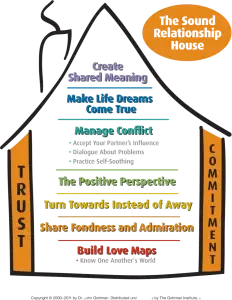Mismatched libidos are one of the most common, and most misunderstood issues couples face in long-term relationships.
According to the Gottmans’ research-based approach, this mismatch often isn’t about incompatibility, but about differing types of desire.
Spontaneous desire is what we typically think of when it comes to sexual interest—it arrives without warning, like a spark. This is the kind of desire often portrayed in media: sudden, urgent, and heat-of-the-moment.
Some examples of spontaneous desire:
- A sudden urge to show affection: This might manifest as a spontaneous hug, kiss, or a gentle touch while passing by.
Impulsive compliments or expressions of love: Telling your partner you love them “just because,” or spontaneously expressing appreciation for them. - Initiating unplanned intimate moments: This could be anything from a quick shower together to cuddling on the couch, or sharing an impromptu romantic evening.
- Sharing personal thoughts or feelings unexpectedly: Opening up about a personal struggle, hope, or dream fosters emotional intimacy.
- A playful gesture or inside joke: This is a lighthearted way to connect and build positive interactions.
There’s another equally valid approach, responsive desire. This type doesn’t necessarily show up before intimacy begins. Instead, it’s activated during or after emotional or physical closeness—through affectionate touch, meaningful connection, or simply feeling safe and seen. People with responsive desire might not feel “in the mood” until they’re already in a moment of closeness. And that’s perfectly normal.
Examples of Responsive Desire:
- A Partner Offers Emotional Support – After a stressful day, one partner listens with empathy and validation. As emotional closeness builds, the other begins to feel more open to intimacy—not because they were already “in the mood,” but because they feel cared for and connected.
- Affectionate Touch Without Expectation – While watching a show, one partner gently strokes the other’s hair or offers a long, comforting hug. This kind of non-sexual touch helps build trust and can naturally evolve into sexual interest.
- Acts of Service – A partner takes care of a chore without being asked, or surprises the other with coffee in the morning. These small gestures may not be sexual in nature but can make the recipient feel appreciated and emotionally bonded—laying the groundwork for desire to emerge.
- Sharing Laughter or Play – Goofing around while making dinner or sharing an inside joke can trigger a feeling of closeness and warmth. This lighthearted connection can then open the door to physical intimacy.
- Emotional Check-ins – Couples who engage in regular rituals of emotional connection (a Gottman principle) often find that emotional attunement leads to sexual openness. Responsive desire thrives when partners feel seen and heard.
- Sensual Connection – A candlelit bath together, giving a massage, or even dancing in the kitchen can set the stage. The mood, the intention, and the sense of safety can turn “not in the mood” into “maybe I am.”
- Repair After Conflict – Gottman emphasizes the importance of repair attempts after conflict. When a couple effectively reconnects after a disagreement, that resolution can restore emotional intimacy and trigger responsive desire, also referred to as “makeup sex”.
For many couples, one partner leans toward spontaneous desire while the other experiences responsive desire. Without understanding this distinction, it’s easy to feel hurt, rejected, or broken. The partner with spontaneous desire may feel unwanted, while the partner with responsive desire may feel pressured or inadequate.
The key insight from the Gottman Method
neither type is better or worse, just different. When couples recognize these patterns, they can stop seeing their sex life as mismatched and start finding ways to connect more intentionally. Talking openly about how desire works for each of you, and creating conditions that support both spontaneous and responsive arousal, couples can build a more fulfilling and compassionate sexual connection—one that grows out of understanding, not frustration.
If this seems familiar and/or a sticky spot in your relationship, schedule a free consultation with me to begin the conversation.




